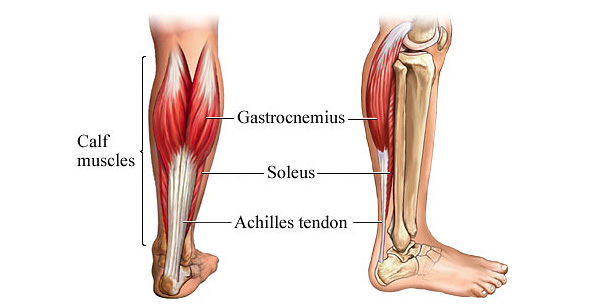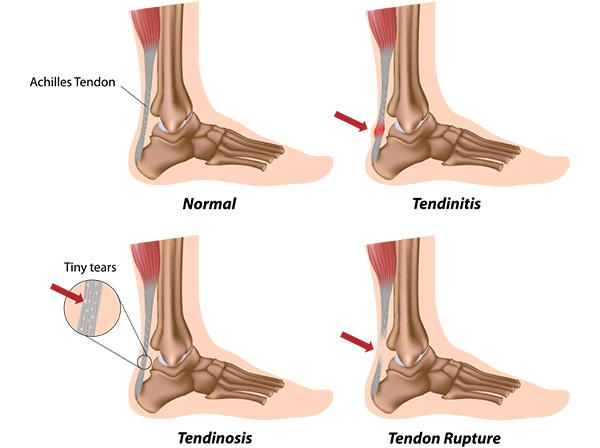Pain or swelling in the back of the foot or just above the heel bone may indicate signs of Achilles Tendonitis.
The Achilles tendon connects the leg to the foot as it stretches from the lower leg to the heel bone, is the largest and strongest tendon in the body. This tendon is crucial to normal walking pattern as it allows the foot to rise up on the toes.

Anatomy of the leg and Achilles tendon.
Achilles Tendonitis typically develops over a period of time as the tendon becomes more and more inflamed. It may include one or more of the following three stages:
Stage 1 — Peri-tendonitis.
Peri-tendonitis is an inflammation involving structures around the Achilles tendon such as the tendon sheathe. This stage is characterized by localized pain and swelling during or after activity.
Stage 2 — Tendinosis.
Tendinosis typically is an asymptomatic degeneration of the Achilles tendon without concomitant inflammation. It is caused by accumulated micro-trauma from repetitive injuries, aging, or both. This stage may result in a nodule that can be palpated at the back of the leg just above the heel.
Stage 3 — Peri-tendonitis with tendinosis.
This stage is characterized by thickening of the Achilles tendon with possible nodules. There are degenerative changes occurring at the tendon along with inflammation. It may lead to a rupture of the tendon if left neglected and it is characterized by pain and swelling during and after activity.

Normal versus diseased Achilles tendon of different stages.
Treatment
Achilles tendonitis is best treated early to prevent further degeneration/spurring and possible rupture.
An experienced foot and ankle specialist can guide you through conservative treatment plan and help you back on your feet. With chronic degeneration of the tendon, calcification or bone spurs may develop over a period of time. Small boney ossicles can be found embedded within the diseased tendon as well as spurring over the back of the heel bone where the Achilles tendon attaches. This area is often very painful with palpation. In some cases, Achilles tendon surgery may be necessary to remove spurring and clean out the diseased portion of the Achilles tendon despite conservative measures. Visit Achilles Tendon Surgery for more information.
If you are experiencing pain and/or swelling in this region, a consultation with our knowledgeable foot and ankle specialist will help you determine what the best course of treatment is. Contact us to book your appointment today.

